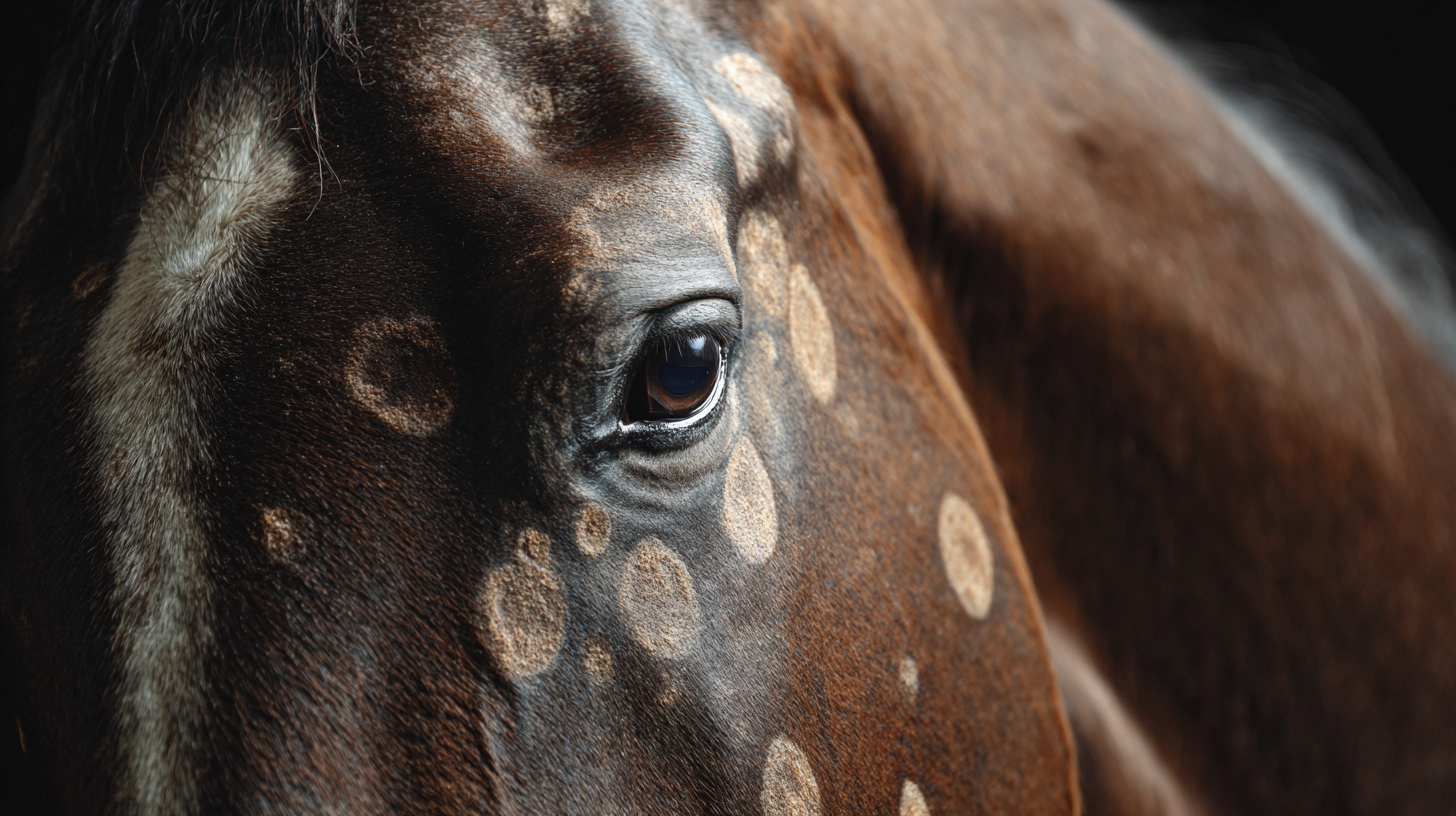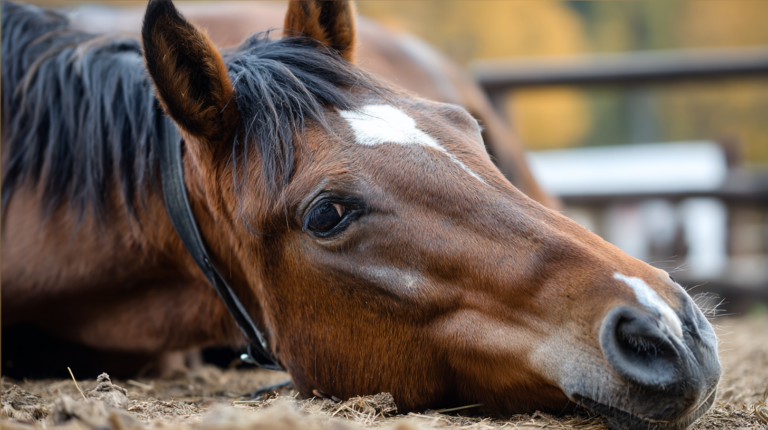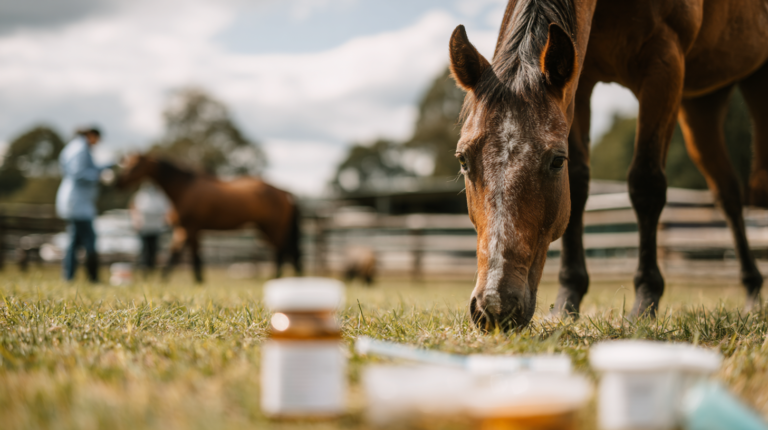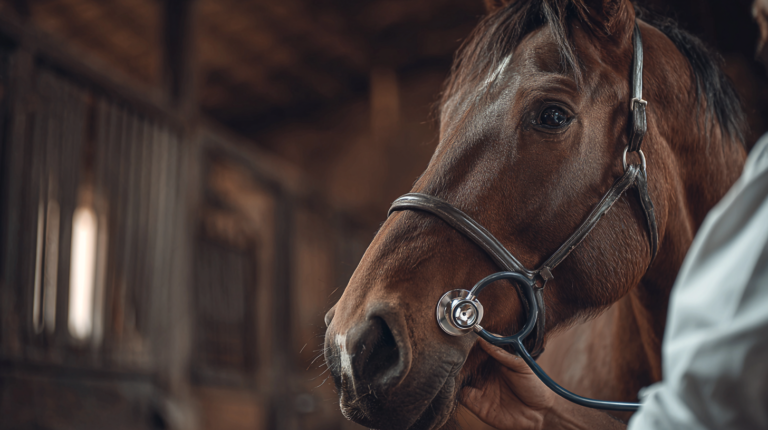Discover the 5 most dangerous fungal infections in horses, their symptoms, and proven treatment methods. Expert veterinary guidance for horse owners.
Table of Contents
Fungal infections in horses represent one of the most challenging health concerns facing equine owners today. These microscopic organisms can cause devastating effects on your horse’s health, ranging from superficial skin irritations to life-threatening systemic conditions. Understanding the nature of these infections, their symptoms, and appropriate treatment protocols is crucial for maintaining your horse’s wellbeing and preventing costly veterinary emergencies.
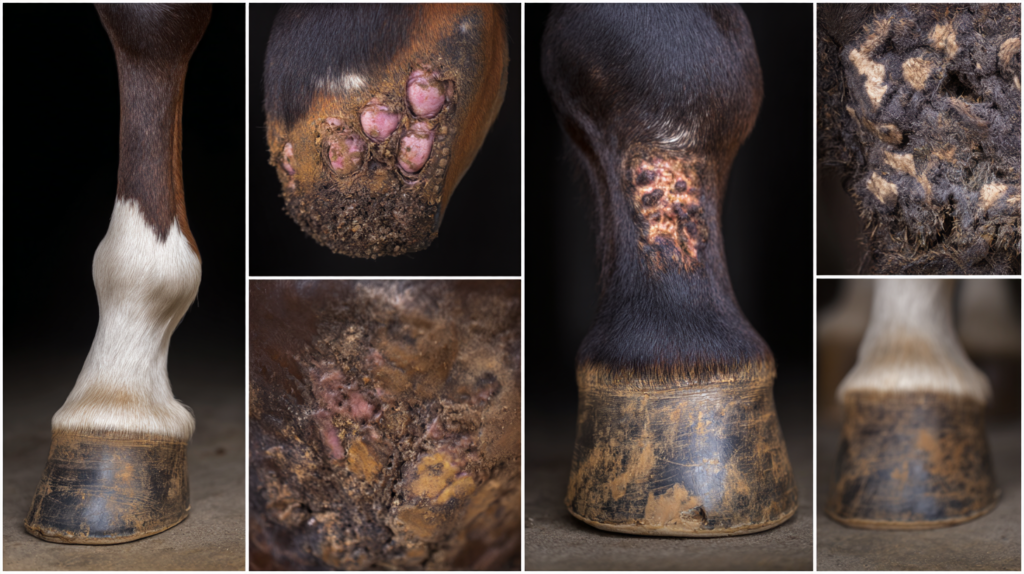
Unlike bacterial infections that respond predictably to antibiotics, fungal infections in horses often require specialized diagnosis and treatment approaches. The equine immune system, while robust in many ways, can struggle against certain fungal pathogens, particularly when horses are stressed, immunocompromised, or exposed to environmental conditions that favor fungal growth. This comprehensive guide will explore the five most dangerous types of fungal infections affecting horses, providing you with the knowledge needed to recognize, treat, and prevent these serious conditions.
| Infection Type | Primary Target System | Severity Level | Common Symptoms | Environmental Risk |
|---|---|---|---|---|
| Aspergillosis | Respiratory System | High | Nasal discharge, coughing, difficulty breathing | Moldy hay, poor ventilation |
| Cryptococcosis | Nervous System | High | Neurological signs, head tilt, seizures | Bird droppings, contaminated soil |
| Histoplasmosis | Systemic/Multiple | Moderate-High | Weight loss, fever, respiratory distress | River valleys, contaminated soil |
| Coccidioidomycosis | Respiratory/Systemic | Moderate | Chronic cough, skin lesions, lameness | Desert regions, dusty conditions |
| Blastomycosis | Multi-System | Variable | Skin nodules, respiratory signs, eye problems | Moist soil, wooded areas |
Understanding Fungal Infections in Equines
Fungal infections, also known as mycoses, occur when pathogenic fungi invade a horse’s body tissues. These organisms thrive in warm, moist environments and can affect virtually any organ system. Unlike bacteria, fungi are eukaryotic organisms with complex cellular structures that make them particularly challenging to eliminate from the body.
The equine respiratory system, with its large surface area and constant exposure to environmental particles, serves as a primary entry point for many fungal pathogens. However, fungal infections can also occur through skin wounds, contaminated feed, or systemic spread from other infected areas. The severity of infection depends on multiple factors, including the specific fungal species, the horse’s immune status, environmental conditions, and the duration of exposure.
Modern veterinary medicine has made significant strides in understanding equine mycology, yet fungal infections remain among the most difficult conditions to diagnose and treat. Many symptoms mimic other diseases, leading to delayed diagnosis and treatment. Early recognition and intervention are critical for successful outcomes, as advanced fungal infections can cause permanent damage to affected organs and may prove fatal in severe cases.
The 5 Most Dangerous Fungal Infections in Horses
1. Aspergillosis: The Silent Respiratory Killer
Aspergillosis represents one of the most serious fungal infections affecting horses worldwide. Caused by various species of Aspergillus fungi, this condition primarily targets the respiratory system but can spread to other organs in severe cases. Aspergillus fumigatus is the most common culprit, though A. niger and A. flavus can also cause disease in horses.
The fungus thrives in organic matter such as hay, straw, and bedding materials. When horses inhale spores from contaminated feed or bedding, the organisms can establish themselves in the respiratory tract. Immunocompromised horses, those under stress, or animals with pre-existing respiratory conditions are particularly vulnerable to aspergillosis.
Early symptoms of aspergillosis include persistent coughing, nasal discharge, and decreased exercise tolerance. As the infection progresses, horses may develop fever, weight loss, and labored breathing. In severe cases, the fungus can invade blood vessels, causing pulmonary hemorrhage and potentially fatal complications.
Diagnosis requires a combination of clinical signs, imaging studies, and laboratory tests. Chest radiographs may reveal characteristic lesions, while endoscopic examination can identify fungal plaques in the respiratory tract. Definitive diagnosis often requires fungal culture or histopathological examination of tissue samples.
Treatment typically involves systemic antifungal medications such as itraconazole or voriconazole. These medications must be administered for extended periods, often 3-6 months or longer, depending on the severity of infection. Environmental management is equally important, focusing on reducing exposure to contaminated materials and improving ventilation in stables.
2. Cryptococcosis: The Neurological Threat
Cryptococcosis, caused by Cryptococcus neoformans, poses a significant threat to horses due to its predilection for the central nervous system. This encapsulated yeast is commonly found in soil contaminated with bird droppings, particularly pigeon excrement. While less common than aspergillosis, cryptococcosis can cause devastating neurological complications.
The infection typically begins as a respiratory condition but can quickly spread to the brain and other organs. Horses with compromised immune systems, including those receiving corticosteroid therapy or suffering from other concurrent diseases, are at increased risk for developing cryptococcosis.
Neurological signs dominate the clinical presentation of cryptococcosis. Affected horses may exhibit ataxia, head pressing, seizures, and behavioral changes. Some horses develop characteristic skin lesions, particularly around the nares and face. The condition can progress rapidly, with some horses deteriorating within days of initial symptom onset.
Diagnosis is challenging and requires specialized laboratory techniques. Cerebrospinal fluid analysis may reveal characteristic encapsulated yeasts, while antigen detection tests can confirm the presence of cryptococcal organisms. Imaging studies of the brain may show characteristic lesions associated with fungal infection.
Treatment involves high-dose antifungal therapy, typically with amphotericin B combined with flucytosine. The prognosis for horses with cryptococcosis is generally poor, particularly when neurological signs are present. Early detection and aggressive treatment offer the best chance for recovery, though many horses require euthanasia due to the severity of neurological complications.
3. Histoplasmosis: The Systemic Invader
Histoplasmosis, caused by Histoplasma capsulatum, represents a significant threat to horses in endemic regions. This dimorphic fungus is commonly found in soil enriched with bat or bird droppings, particularly in river valleys and areas with high humidity. The organism exists as a mold in the environment but transforms into a yeast form when it enters the body.
Horses typically become infected through inhalation of fungal spores during activities such as trail riding in wooded areas or exposure to contaminated soil. The infection can remain localized to the respiratory system or spread systemically, affecting multiple organs including the liver, spleen, and bone marrow.
The clinical presentation of histoplasmosis varies depending on the extent of infection. Acute cases may present with fever, coughing, and respiratory distress, while chronic infections can cause weight loss, depression, and intermittent fever. Some horses develop cutaneous lesions or lymph node enlargement.
Diagnosis requires a combination of clinical signs, imaging studies, and specialized laboratory tests. Radiographic examination may reveal pulmonary infiltrates or lymph node enlargement. Definitive diagnosis often requires identification of the organism in tissue samples or positive serology tests.
Treatment typically involves long-term antifungal therapy with itraconazole or amphotericin B. The duration of treatment depends on the severity of infection and the horse’s response to therapy. Environmental management focuses on reducing exposure to contaminated soil and improving ventilation in stable areas.
4. Coccidioidomycosis: The Desert Danger
Coccidioidomycosis, also known as Valley Fever, is caused by Coccidioides immitis and C. posadasii. This infection is endemic to arid regions of the southwestern United States and parts of Mexico. The fungus exists as a mold in alkaline soil and produces highly infectious arthroconidia that can be dispersed by wind.
Horses become infected through inhalation of arthroconidia during dust storms or when soil is disturbed. The organism can cause both pulmonary and disseminated infections, with the latter being more serious and potentially fatal. Horses that are immunocompromised or under stress are at higher risk for developing severe disease.
Clinical signs of coccidioidomycosis include persistent coughing, fever, weight loss, and lethargy. Some horses develop characteristic skin lesions or lymph node enlargement. In severe cases, the infection can spread to bones, joints, and other organs, causing lameness and systemic illness.
Diagnosis relies on serology tests to detect antibodies against Coccidioides organisms. Radiographic examination may reveal characteristic pulmonary lesions, while tissue samples can confirm the presence of the fungus. Early diagnosis is crucial for successful treatment outcomes.
Treatment involves long-term antifungal therapy, typically with fluconazole or itraconazole. The duration of treatment may extend for several months or even years in severe cases. Environmental management focuses on reducing dust exposure and providing adequate ventilation in stable areas.
5. Blastomycosis: The Multi-System Threat
Blastomycosis, caused by Blastomyces dermatitidis, represents a serious fungal infection that can affect multiple organ systems in horses. This dimorphic fungus is commonly found in moist soil rich in organic matter, particularly in areas near water sources. The organism exists as a mold in the environment but transforms into a characteristic broad-based budding yeast in the body.
Horses typically become infected through inhalation of fungal conidia, though cutaneous inoculation can also occur. The infection can remain localized to the respiratory system or spread to other organs, including the skin, bones, and central nervous system. Disseminated blastomycosis carries a poor prognosis and requires aggressive treatment.
Clinical signs of blastomycosis vary depending on the organs affected. Pulmonary infections may cause coughing, dyspnea, and fever, while cutaneous forms present with characteristic skin lesions that may ulcerate and drain. Systemic infections can cause weight loss, depression, and organ-specific symptoms.
Diagnosis requires identification of the characteristic broad-based budding yeasts in tissue samples or positive culture results. Serology tests may be helpful but are not always reliable. Radiographic examination can reveal characteristic pulmonary lesions in cases of respiratory involvement.
Treatment involves systemic antifungal therapy with amphotericin B or itraconazole. The choice of medication depends on the severity of infection and the horse’s overall condition. Treatment duration is typically prolonged, often requiring several months of therapy.
| Age Group | Timing | Vaccine Type | Route | Booster Required | Special Notes |
|---|---|---|---|---|---|
| Pregnant Does | 4-6 weeks before kidding | CDT (8-way) | Subcutaneous | Annual | Provides passive immunity to kids |
| Kids (Initial) | 6-8 weeks of age | CDT | Subcutaneous | Yes | First vaccination in series |
| Kids (Booster) | 10-12 weeks of age | CDT | Subcutaneous | Annual thereafter | Complete initial immunity |
| Adult Goats | Annual | CDT (8-way) | Subcutaneous | Every 12 months | Spring vaccination recommended |
| High-Risk Adults | Every 6 months | CDT | Subcutaneous | Bi-annual | Breeding bucks, show animals |
| New Arrivals | Upon arrival + 3 weeks | CDT | Subcutaneous | Two-shot series | Quarantine protocol essential |
Early Detection and Diagnostic Approaches
Early detection of fungal infections in horses requires a high index of suspicion and thorough diagnostic workup. Many fungal infections present with non-specific symptoms that can be easily mistaken for other conditions. Horse owners should be alert to persistent respiratory symptoms, unexplained weight loss, or chronic skin lesions that fail to respond to conventional treatment.
Veterinary diagnosis of fungal infections typically involves a multi-step approach combining clinical examination, laboratory tests, and imaging studies. Blood work may reveal non-specific changes such as anemia or elevated white blood cell counts. However, definitive diagnosis often requires more specialized techniques.
Cytological examination of respiratory secretions, skin scrapings, or tissue samples can sometimes reveal characteristic fungal elements. Culture techniques remain the gold standard for diagnosis but can be time-consuming, with some fungi requiring several weeks to grow. Molecular diagnostic techniques, including PCR testing, offer faster results but may not be available in all laboratories.
Serological tests measure antibody responses to specific fungal antigens and can be valuable diagnostic tools. However, these tests must be interpreted carefully, as positive results may indicate past exposure rather than active infection. Additionally, immunocompromised horses may not mount adequate antibody responses.
Imaging studies, including radiographs, ultrasonography, and advanced techniques like CT or MRI, can provide valuable information about the extent and severity of fungal infections. These studies are particularly useful for evaluating respiratory tract involvement and monitoring treatment response.
Treatment Protocols and Management Strategies
Successful treatment of fungal infections in horses requires a comprehensive approach combining systemic antifungal therapy, supportive care, and environmental management. The choice of antifungal medication depends on the specific fungal species, the severity of infection, and the horse’s overall health status.
Systemic antifungal medications commonly used in horses include itraconazole, fluconazole, voriconazole, and amphotericin B. Each medication has specific advantages and limitations. Itraconazole is effective against a broad spectrum of fungi and is generally well-tolerated by horses. However, it can be expensive and may cause gastrointestinal upset in some animals.
Fluconazole offers excellent tissue penetration and is particularly useful for central nervous system infections. It is generally well-tolerated but may be less effective against certain fungal species. Voriconazole provides broad-spectrum antifungal activity and good tissue penetration but can be expensive and may cause visual disturbances in some horses.
Amphotericin B remains the gold standard for severe fungal infections but carries significant risks of kidney toxicity and other side effects. It is typically reserved for life-threatening infections or cases that fail to respond to other treatments.
Treatment duration varies depending on the specific infection and the horse’s response to therapy. Most fungal infections require extended treatment periods, often 3-6 months or longer. Premature discontinuation of treatment can lead to relapse and development of drug resistance.
Supportive care plays a crucial role in managing horses with fungal infections. This may include anti-inflammatory medications to reduce tissue damage, bronchodilators for respiratory symptoms, and nutritional support to maintain body condition. Regular monitoring of kidney and liver function is essential during antifungal treatment.
Environmental management is equally important for treatment success and prevention of reinfection. This includes identifying and eliminating sources of fungal contamination, improving ventilation in stables, and implementing proper feed storage practices.
| Treatment Phase | Duration | Primary Medications | Monitoring Requirements | Expected Cost Range | Success Rate |
|---|---|---|---|---|---|
| Initial Diagnosis | 1-3 days | Diagnostic Tests Sample Collection | Clinical examination, laboratory workup | $500-$1,500 | 85-95% |
| Acute Treatment | 2-8 weeks | Itraconazole Fluconazole Amphotericin B | Weekly blood work, liver function tests | $1,000-$3,000 | 70-80% |
| Maintenance Phase | 3-6 months | Oral Antifungals Supportive Care | Monthly monitoring, symptom assessment | $2,000-$5,000 | 65-75% |
| Recovery Monitoring | 6-12 weeks | Probiotics Immune Support | Bi-weekly check-ups, imaging studies | $500-$1,200 | 80-90% |
| Long-term Management | 6+ months | Preventive Care Environmental Control | Quarterly evaluations, environmental assessment | $300-$800/quarter | Variable |
| Emergency Intervention | 24-72 hours | IV Antifungals Intensive Support | Continuous monitoring, ICU care | $3,000-$8,000 | 50-70% |
Prevention and Environmental Control
Prevention of fungal infections in horses relies heavily on environmental management and good husbandry practices. Understanding the environmental conditions that favor fungal growth allows horse owners to implement effective prevention strategies.
Proper feed storage is crucial for preventing exposure to fungal spores. Hay and grain should be stored in dry, well-ventilated areas away from sources of moisture. Moldy or dusty feed should never be fed to horses, as it can contain high concentrations of fungal spores. Regular inspection of feed quality and prompt disposal of questionable materials can significantly reduce infection risk.
Stable ventilation plays a critical role in preventing fungal infections. Adequate air circulation helps reduce humidity and removes airborne spores before they can accumulate to dangerous levels. Mechanical ventilation systems should be regularly maintained and cleaned to prevent the buildup of dust and organic matter.
Bedding materials can harbor fungal organisms, particularly if they become wet or contaminated. Stalls should be cleaned regularly, and wet bedding should be promptly removed. Choosing appropriate bedding materials and ensuring adequate drainage can help maintain a healthier environment.
Pasture management also contributes to fungal infection prevention. Overgrazing can lead to soil erosion and dust generation, increasing the risk of spore inhalation. Proper pasture rotation and maintenance can help minimize these risks.
Regular health monitoring allows for early detection of fungal infections before they become severe. Horse owners should be alert to changes in their animals' behavior, appetite, or physical condition. Prompt veterinary attention for persistent respiratory symptoms or unexplained illness can prevent minor infections from becoming serious health threats.
When to Seek Emergency Veterinary Care
Certain symptoms associated with fungal infections require immediate veterinary attention. Horse owners should contact their veterinarian immediately if their horse exhibits severe respiratory distress, including rapid breathing, flared nostrils, or cyanosis (blue coloration of mucous membranes). These signs may indicate advanced pulmonary infection or complications such as pulmonary hemorrhage.
Neurological symptoms, including ataxia, seizures, or altered mental state, warrant emergency evaluation. These signs may indicate central nervous system involvement, which carries a poor prognosis and requires aggressive treatment. Early intervention may be critical for preventing permanent neurological damage.
Acute onset of severe illness, particularly when accompanied by high fever, depression, or collapse, should prompt immediate veterinary evaluation. Systemic fungal infections can progress rapidly and may be life-threatening without prompt treatment.
Persistent or worsening symptoms despite treatment also require veterinary reassessment. This may indicate treatment failure, drug resistance, or the presence of concurrent conditions that complicate recovery.
Long-term Management and Prognosis
The prognosis for horses with fungal infections varies significantly depending on the specific organism involved, the extent of infection, and the timeliness of treatment. Localized infections generally carry a better prognosis than systemic or disseminated diseases.
Respiratory fungal infections may require long-term management even after successful treatment. Some horses develop permanent respiratory compromise that affects their athletic performance. Regular monitoring and supportive care can help maintain quality of life in these animals.
Horses that survive severe fungal infections may require ongoing monitoring for recurrence. Some individuals may be predisposed to reinfection, particularly if they have underlying immune system dysfunction or continued exposure to contaminated environments.
The financial impact of treating fungal infections can be significant. Treatment costs often exceed several thousand dollars, and some cases require months of expensive antifungal therapy. Pet insurance may help offset these costs, but coverage varies between policies.
Latest Research and Treatment Advances
Recent advances in veterinary mycology have led to improved diagnostic techniques and treatment options for equine fungal infections. Molecular diagnostic methods, including real-time PCR and next-generation sequencing, offer faster and more accurate identification of fungal pathogens.
New antifungal medications continue to be developed and evaluated for use in horses. Posaconazole and isavuconazole show promise for treating refractory fungal infections, though their use in horses is still being investigated.
Immunotherapy approaches, including the use of interferon and other immune modulators, may offer additional treatment options for horses with compromised immune systems. These therapies aim to enhance the host's natural ability to fight fungal infections.
Research into fungal resistance mechanisms has highlighted the importance of appropriate antifungal use and the need for combination therapies in some cases. Understanding these mechanisms helps veterinarians choose the most effective treatment protocols.
Frequently Asked Questions
Get answers to the most common questions about fungal infections in horses
No matching questions found
Try searching with different keywords or browse all questions above.
For more expert pet care tips and product recommendations, visit https://BlithePet.com — your trusted source for pet wellness.
Conclusion
Fungal infections in horses represent a complex and challenging group of diseases that require careful attention from horse owners and veterinary professionals. The five dangerous types discussed in this article—aspergillosis, cryptococcosis, histoplasmosis, coccidioidomycosis, and blastomycosis—can cause serious illness and even death if not properly recognized and treated.
Early detection remains the key to successful treatment outcomes. Horse owners should maintain vigilant observation of their animals' health and seek prompt veterinary attention for persistent respiratory symptoms, unexplained weight loss, or other concerning signs. Environmental management, including proper feed storage, adequate ventilation, and good stable hygiene, plays a crucial role in preventing fungal infections.
While treatment of fungal infections can be lengthy and expensive, advances in diagnostic techniques and antifungal therapies offer hope for improved outcomes. Working closely with experienced veterinarians and following recommended treatment protocols gives horses the best chance for recovery from these serious infections.
The investment in prevention through proper environmental management and regular health monitoring is far less than the cost of treating established fungal infections. By understanding the risks and implementing appropriate prevention strategies, horse owners can significantly reduce their animals' risk of developing these potentially devastating conditions.
Have a similar experience with your pet? Share it in the comments below!

